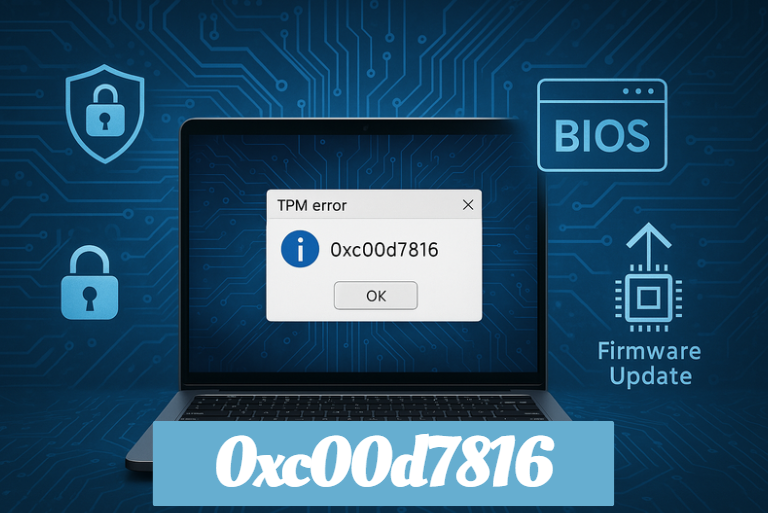In-Depth Guide to Fixing 0xc00d7816: Causes, Troubleshooting, and Prevention
The 0xc00d7816 error is an issue that typically arises when there is a problem with the Trusted Platform Module (TPM) on your Windows device. TPM is a specialized hardware component that stores encryption keys and performs cryptographic functions, supporting essential security features such as BitLocker and Windows Hello. When the TPM malfunctions, is misconfigured, or its firmware becomes outdated, Windows may display the 0xc00d7816 error, disrupting system functionality.
In this guide, you will learn what this error means, the underlying causes, and how to troubleshoot and prevent it. This article is designed to be both informative and accessible, so whether you’re a novice or an IT professional, you’ll find valuable insights to keep your system running smoothly.
Understanding the Trusted Platform Module (TPM)
What Is TPM and Its Role in Windows Security?
The Trusted Platform Module (TPM) is a dedicated microcontroller embedded in many modern computers. It securely stores encryption keys, digital certificates, and other credentials. In simple terms, TPM acts as the security guardian for your device, ensuring that sensitive data remains protected.
Windows relies on TPM for various features, including BitLocker encryption and secure boot operations. Understanding TPM is crucial because a failure in this component often leads to errors like 0xc00d7816.
How TPM Works and Why It Matters
TPM operates by creating and managing cryptographic keys in a secure environment. When you use features like Windows Hello or BitLocker, TPM ensures that your authentication credentials and encrypted data remain protected from unauthorized access. The following table illustrates TPM’s key functions:
| TPM Function | Description |
|---|---|
| Key Storage | Securely stores cryptographic keys |
| Encryption/Decryption | Handles encryption and decryption of sensitive data |
| Secure Boot Support | Verifies system integrity during startup |
| Digital Certificate Storage | Stores and manages digital certificates for secure communication |
This functionality underpins the overall security framework of your system. When any of these components fail, errors like 0xc00d7816 can occur, potentially leaving your system vulnerable.
Detailed Analysis of 0xc00d7816
What Does the 0xc00d7816 Error Mean?
The 0xc00d7816 error typically appears when Windows detects an issue with the TPM. The error message often surfaces during system boot or when performing security-related operations. This error indicates that the TPM may be misconfigured, its firmware outdated, or there is a hardware fault affecting its performance. Users might notice problems such as failure to log in using Windows Hello or issues with BitLocker encryption.
Root Causes of the 0xc00d7816 Error
Multiple factors can contribute to the 0xc00d7816 error. Understanding these causes is essential for effective troubleshooting. The primary reasons include:
- TPM Malfunction or Misconfiguration: A common cause is an improperly enabled TPM in the BIOS/UEFI settings.
- Outdated TPM Firmware/Drivers: Firmware and drivers need regular updates to maintain compatibility with Windows security features.
- BIOS/UEFI Settings Issues: Incorrect settings in the BIOS/UEFI can interfere with the TPM’s functionality.
- Third-Party Software Conflicts: Some security applications or system utilities may inadvertently disrupt TPM operations.
Comprehensive Troubleshooting Steps
Addressing the 0xc00d7816 error involves a systematic approach. The following sections provide a detailed explanation of each step, using paragraphs, lists, and tables for clarity.
Initial Diagnosis and Verification
Before making changes, it is important to verify the error:
- Verify the Error: Confirm that you are indeed facing the 0xc00d7816 error by reviewing Windows Event Viewer logs or using TPM management tools.
- System Tools: Tools such as the TPM Management Console (tpm.msc) can help check the status of your TPM.
Checking TPM Status in BIOS/UEFI
Accessing the BIOS/UEFI is a critical step:
- Restart your computer and enter the BIOS/UEFI setup by pressing the designated key (usually F2, Del, or Esc).
- Navigate to the security settings and verify that the TPM is enabled. Look for settings like “TPM Security” or “Trusted Platform Module.”
- If the TPM is disabled, enable it and save the changes.
The following list outlines the steps to access and verify TPM settings:
- Restart the PC.
- Enter BIOS/UEFI setup.
- Locate TPM settings under the “Security” or “Advanced” tab.
- Enable TPM if it is disabled.
- Save changes and exit.
Updating TPM Firmware and Drivers
Keeping the TPM firmware and drivers current can resolve many issues:
- Manufacturer’s Website: Visit your device or motherboard manufacturer’s support page to download the latest TPM firmware and drivers.
- Installation Process: Follow the installation instructions carefully. It is advisable to back up your data before updating firmware.
A simple table can help illustrate the update process:
| Step | Action |
|---|---|
| Check Current Version | Use TPM management tools to view the current firmware version |
| Download Update | Go to the manufacturer’s website and download the latest firmware/driver |
| Install Update | Follow on-screen instructions and restart your computer after installation |
| Verify Installation | Re-check the firmware version in TPM management tools to confirm the update |
Resetting or Clearing the TPM
If updating does not resolve the issue, resetting the TPM may be necessary:
- Backup Critical Data: Before resetting, back up important data, especially if you use BitLocker encryption.
- Clear TPM: Access the TPM settings in Windows Security or BIOS/UEFI and select the option to clear the TPM. Note that this will delete stored keys, so caution is advised.
Running Windows Update and System Integrity Checks
In some cases, running system tools can help:
- Windows Update: Ensure your system is fully updated, as Microsoft often releases patches that address TPM issues.
- SFC and DISM Commands: Open Command Prompt as an administrator and run the following commands:
sfc /scannowDISM /Online /Cleanup-Image /RestoreHealth
These commands check and repair system files that might be contributing to the error.
Additional Quick Fixes
Some other simple remedies can also be attempted:
- Restart your computer and recheck the TPM settings.
- Disconnect any external devices that might cause interference.
- Temporarily disable third-party security software to test if it’s affecting TPM operations.
Advanced Troubleshooting and Solutions
For persistent issues, advanced solutions might be necessary:
Diagnosing Firmware and Hardware Conflicts
If basic troubleshooting fails, you may need to consider:
- Hardware Inspection: Inspect your motherboard and TPM module for any signs of damage or incompatibility.
- Contact Support: In cases of hardware failure, contacting the device manufacturer’s technical support may provide additional insights.
Advanced BIOS/UEFI Tweaks
For advanced users:
- Delve deeper into the BIOS/UEFI settings to adjust advanced TPM configurations.
- Experiment with enabling or disabling specific security features to determine their impact on TPM functionality.
Utilizing Third-Party Diagnostic Tools
There are robust third-party tools available:
- Use specialized diagnostic software to perform a deep analysis of your system’s hardware and firmware.
- Interpret the results using the software’s documentation to pinpoint potential conflicts or errors related to TPM.
Reinstalling or Repairing Windows
When all else fails:
- Consider performing a repair installation of Windows. This process retains your files while reinstalling the operating system.
- As a last resort, a complete clean installation may be necessary. Ensure that you back up all important data and have a recovery plan in place.
Real-World Case Studies and User Experiences
Learning from others’ experiences can offer valuable insights:
- Home User Scenario: A typical home user encountered the 0xc00d7816 error after a Windows update. They solved the problem by enabling TPM in the BIOS and updating the firmware, which restored system functionality.
- Enterprise-Level Resolution: In a corporate environment, IT professionals faced widespread issues due to outdated TPM firmware. By deploying a company-wide update and adjusting BIOS settings remotely, the error was resolved.
These case studies highlight common pitfalls and effective solutions. They also underscore the importance of regular system maintenance and proactive updates.
Best Practices for Preventing TPM-Related Issues
Maintaining system health is key to avoiding the 0xc00d7816 error:
- Regular Updates: Always keep your TPM firmware, drivers, and Windows updates current. Consider scheduling monthly checks.
- Optimized BIOS/UEFI Settings: Use recommended settings from your manufacturer to ensure compatibility and performance.
- Routine System Maintenance: Perform regular diagnostics using built-in tools like SFC and DISM, and consider third-party software for deeper analysis.
A simple checklist for best practices might include:
- Schedule regular firmware and driver updates.
- Backup critical data before making any changes.
- Perform system diagnostics periodically.
- Monitor system performance and review event logs for early warning signs.
Frequently Asked Questions (FAQs)
Q1: What are some alternative diagnostic tools beyond the built-in TPM Management Console?
While Windows provides tools like tpm.msc, you might also consider third-party utilities designed for hardware health monitoring. These tools often offer detailed reporting on chip temperature, voltage stability, and potential errors that may not be evident through standard utilities. Such software can be valuable in preemptively identifying anomalies before they escalate into more significant issues.
Q2: How can a BIOS/UEFI update impact the operation of TPM?
BIOS/UEFI updates can refine how your system interfaces with TPM hardware. Manufacturers sometimes release firmware updates to resolve compatibility issues or improve security protocols, which may enhance the TPM’s performance. It is wise to review the update logs and manufacturer documentation because even a minor update might change the interaction between the system firmware and the TPM module.
Q3: Does TPM play a role in compliance with certain security standards?
Yes, TPM is an integral component in meeting various industry and regulatory security standards. Organizations that handle sensitive data often require TPM-enabled hardware as part of their compliance framework. This built-in security measure helps satisfy requirements for secure key storage and data encryption mandated by standards like FIPS 140-2 and others.
Q4: What options are available if TPM-related issues persist and hardware replacement becomes necessary?
If troubleshooting and firmware updates do not resolve persistent TPM issues, the next step may be to consider a hardware upgrade or replacement. In enterprise settings, this might involve replacing the motherboard or dedicated TPM chip. For individual users, contacting the manufacturer for repair or replacement under warranty could be the best course of action.
Q5: How can I proactively monitor TPM health to avoid future errors?
Proactive monitoring involves setting up regular system health checks using both Windows’ built-in diagnostics and external monitoring software. Scheduled scans and periodic reviews of system logs can help detect early warning signs of TPM degradation. Moreover, subscribing to manufacturer notifications regarding firmware updates or recalls can alert you to emerging issues before they impact your system.
Conclusion
In summary, the 0xc00d7816 error is closely tied to issues with the Trusted Platform Module (TPM) in your Windows system. By understanding how TPM works and following our detailed troubleshooting steps—from checking BIOS/UEFI settings and updating firmware to advanced diagnostics and user case studies—you can effectively resolve the error and maintain system security. Regular maintenance and proactive updates are the best defenses against such errors, ensuring that your system remains stable and secure.
This guide is designed to be a complete resource on the 0xc00d7816 error, offering clear instructions, practical solutions, and expert insights. By implementing the best practices discussed, you can prevent future issues and keep your system operating at its best.
Read more
The Ultimate Guide to classroom 15x: Revolutionizing Education Through Innovation and Technology
The Ultimate Guide to what cilfqtacmitd help with – Unlocking Efficiency Across Industries






